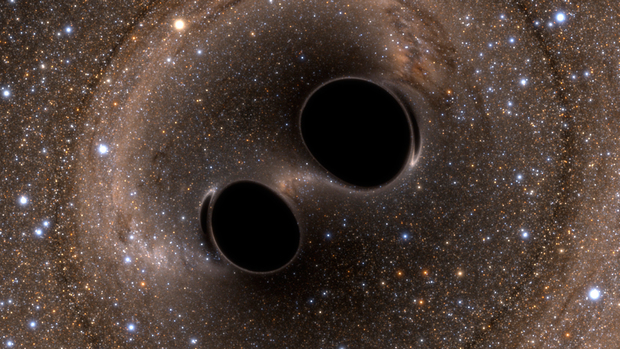International researchers who studied the merging of two black holes say their new observations match theories developed by Stephen Hawking and NZ scientist Roy Kerr over half a century ago.
Professor Roy Kerr’s 1963 research elegantly explained what space and time look like near a spinning black hole, predicting effects like space being ‘dragged’ around and light looping to make multiple copies of objects.
The new study is based on a gravitational wave signal picked up in January this year. One of the study authors said the “exquisitely clear” data meant they could identify two ‘tones’ from the “black hole voices”, and confirm they behaved according to Kerr’s theory.
The SMC asked local experts to comment.
Professor Roy Kerr, Canterbury Distinguished Professor, University of Canterbury, comments:
Note: Professor Kerr is the author of the foundational research referenced in the new paper.
“The observations and calculations of the original mergers of black holes were fairly rough. The problem was getting the best fit for the masses and spins of the three black holes involved. These have improved out of sight. However, we still need some other way to confirm the theory involved.
“Still, it appears that the colliding objects fit my construction! I love it!
“Do they fit the Stephen Hawking result? Seems so. When people talk about the area of a black hole they are really talking about the mass if it stopped spinning. The spin creates energy that adds to the mass seen outside the black hole.
“This was also observed by me when I was calculating the motion of two fast moving stars in 1958. I was surprised to discover this invariant mass.”
No conflicts of interest.
Dr Yvette Perrott, Senior Lecturer in the School of Chemical and Physical Sciences, Te Herenga Waka – Victoria University of Wellington, comments:
“The detection of gravitational waves is an extraordinary feat of both engineering, requiring the detection of changes in length of less than 10-18 m (or about 1/1000th the radius of a proton), and theoretical physics, validating our understanding of general relativity and gravity when applied to extreme objects such as black holes. Now, only 10 years on from the first gravitational wave detection, we are detecting gravitational waves from black hole merger events with such incredible precision that we can test fundamental properties of black holes predicted by New Zealander Roy Kerr and Stephen Hawking, which not so long ago were purely theoretical.
“This type of research, while it may not have any immediate economic benefit, allows us to use the Universe as our physics laboratory – testing fundamental theories in extreme environments which we would have no hope of emulating on Earth. Gravitational wave research is only going to get more exciting as we look ahead to the next generation of detectors such as the space-based Laser Interferometer Space Antenna, so watch this space (pun intended)!”
Professor Richard Easther, Department of Physics; and Laura Burn, PhD student working on gravitational waves and black hole physics, University of Auckland, comment:
“This is a lovely result and it underlines how far gravitational wave science has come since the first black hole merger was detected, almost exactly 10 years ago. This event looks a lot like that first one but the LIGO detectors have been improved significantly so we get a much crisper signal.
“As two black holes orbit closer and closer together, their gravitational wave signal increases until they merge, releasing the strongest burst of gravitational waves. Finally, the newly formed single black hole goes through the “ringdown”, vibrating like a bell as it settles down to its final shape. The gravitational wave signal from this last stage is weaker than the actual merger and this is the clearest view we have ever had of this part of the process.
“Physics tells us that a black hole that forms from a merger will retain the “spin” of the original orbiting pair. This means that the new, single black hole should obey the Kerr solution to Einstein’s equations of General Relativity – which was found by New Zealand mathematician Roy Kerr in 1963. The new results from LIGO show that the ringdown matches expectations for a Kerr black hole, confirming that General Relativity is working well even in these extreme conditions.
“On top of that we can also get a measure of the surface area of the new black hole from this signal. One of the things Stephen Hawking was famous for was his prediction that the surface area of a merged black hole should always be larger than the combined area of its predecessors – for much the same reason that entropy, a measurement of disorder, tends to increase in simple systems. These new observations let us test that prediction with data for the first time – and it checks out.
“The lovely thing about this result is that it marks progress from simply verifying that gravitational waves exist – which was a Nobel winning result – to actually being able to use them to test our understanding of gravity in the most extreme environments in the universe since the big bang itself.”
No conflicts of interest.
